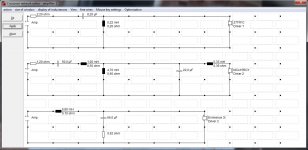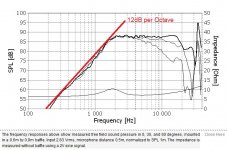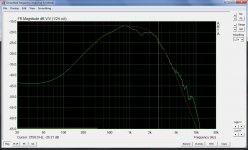My 3-way speakers treble range is strident and irritating. On-axis FR is fairly flat with slight dip at 3kHz, phase tracking is good, off-axis response is good, no cone breakup is present from the midrange (Seas mca15rcy).
Actual mid to tweeter xo is measured acoustical LR4 at 2kHz (tried from 1700-3200Hz LR2 and LR4).
If i decrease the tweeter level the sound becomes dull, if i increase the level then becomes tiresome.
Highpass series capacitor is Jantzen Superior-Z, tried Crosscap which was slightly better i think but slightly dark sounding with less perceived detail.
Maybe the tweeter (Seas 27tffc) has this signature to the sound?
This driver can be found in many expensive loudspeakers (mainly PMC, from cheaper to the most expensive models) with very good reputation.
This cheap tweeter sounds simply cheap? Where do i start to resolve this issue?
Thanks!
Denes
Actual mid to tweeter xo is measured acoustical LR4 at 2kHz (tried from 1700-3200Hz LR2 and LR4).
If i decrease the tweeter level the sound becomes dull, if i increase the level then becomes tiresome.
Highpass series capacitor is Jantzen Superior-Z, tried Crosscap which was slightly better i think but slightly dark sounding with less perceived detail.
Maybe the tweeter (Seas 27tffc) has this signature to the sound?
This driver can be found in many expensive loudspeakers (mainly PMC, from cheaper to the most expensive models) with very good reputation.
This cheap tweeter sounds simply cheap? Where do i start to resolve this issue?
Thanks!
Denes
Yes, this one!
I think you have too low a crossover and too low an order on that tweeter. Troels uses your mid and 27TFFC tweeter here:
Poor Man'
3kHz and third or even fourth order ought to sound a whole heap better. You shouldn't have much difficulty adjusting the mid for 3Khz.
TBH, I never like second order tweeter at all. Sounds distorted to me. 4th order transforms most tweeters.
I would want to model it to see how phase and bafflestep lines up, but really 4th order is dead easy, IMO. 4.7uF/0.2mH/6.8uF/0.3mH and a couple of resistors should do it for 3kHz. Maybe even a little half zobel around 15R and 0.33uF.
Poor Man'
3kHz and third or even fourth order ought to sound a whole heap better. You shouldn't have much difficulty adjusting the mid for 3Khz.
TBH, I never like second order tweeter at all. Sounds distorted to me. 4th order transforms most tweeters.
I would want to model it to see how phase and bafflestep lines up, but really 4th order is dead easy, IMO. 4.7uF/0.2mH/6.8uF/0.3mH and a couple of resistors should do it for 3kHz. Maybe even a little half zobel around 15R and 0.33uF.
My 3-way speakers treble range is strident and irritating. On-axis FR is fairly flat with slight dip at 3kHz, phase tracking is good, off-axis response is good, no cone breakup is present from the midrange (Seas mca15rcy).
Actual mid to tweeter xo is measured acoustical LR4 at 2kHz (tried from 1700-3200Hz LR2 and LR4).
If i decrease the tweeter level the sound becomes dull, if i increase the level then becomes tiresome.
Highpass series capacitor is Jantzen Superior-Z, tried Crosscap which was slightly better i think but slightly dark sounding with less perceived detail.
Maybe the tweeter (Seas 27tffc) has this signature to the sound?
This driver can be found in many expensive loudspeakers (mainly PMC, from cheaper to the most expensive models) with very good reputation.
This cheap tweeter sounds simply cheap? Where do i start to resolve this issue?
Thanks!
Denes
I'm in agreement with you.
I have 27TDFC/G, 27TBFC/G and 27TDFC (without grille / acoustic lense).
Here's my findings when crossed ~ 2KHz in a 3 way. The mid and woofer are capable of out playing the tweeter at volume. Things start to compress. I have 350 watts into 4 Ohms on tap so it isn't a supply issue. In a 2 way, the midwoofer starts to distort on bass at the same time - or before the tweeter gives up, so you don't notice it
Many pop / rock recordings have a lot of energy between 2.5Khz and 4Khz. Orchestral works are demanding. The Seas tweeter just doesn't seem capable of handling this. I have found I need some serious broad Q notching to tame this area.
My issue is I've chosen a midwoofer that cannot play higher due to its distortion products, but a tweeter that's not happy at 2KHz.
I'd agree fully with system7 here. Your mca15rcy should be ok up to 3KHz. move your xo up to that and see how you go. you may be able to stay 2nd order electric on the tweeter, but have steeper order up your sleeve if needed.
Make sure you play the tweeter with crossover by itself both before and after changes on the strident material. It confirms you're moving in the right direction. Phase matching / level matching yada, yada doesn't matter when a driver just plain sounds horrible.
Thanks the suggestions guys!
I moved the xo point to around 2.8kHz LR4 with 3rd order electrical on the tweeter. Now this is not just slightly better, but much-much better than before and this is with cheap Jantzen Cross-Caps (now i think i don't need "better" caps) in the signal path.
Interestingly, people are sometimes very attached to their ideas. I originally chosed the 2kHz xo point to try avoid the elevated 3rd harmonic distortion from the midrange driver around this region and as a plus, the tweeter needs only a second order network combined with its natural roll-off to produce a matching LR4 slope. That was.
Another thing is the so called "super" caps. These can be very expensive and every time I heard it, I had the feeling that they add some unwanted things to the signal, but that may be just me.
Otherwise can you suggest some good tweeters which works with low xo point? Or this is generally not a good idea with the usual 1 inch domes?
Thanks!
I moved the xo point to around 2.8kHz LR4 with 3rd order electrical on the tweeter. Now this is not just slightly better, but much-much better than before and this is with cheap Jantzen Cross-Caps (now i think i don't need "better" caps) in the signal path.
Interestingly, people are sometimes very attached to their ideas. I originally chosed the 2kHz xo point to try avoid the elevated 3rd harmonic distortion from the midrange driver around this region and as a plus, the tweeter needs only a second order network combined with its natural roll-off to produce a matching LR4 slope. That was.
Another thing is the so called "super" caps. These can be very expensive and every time I heard it, I had the feeling that they add some unwanted things to the signal, but that may be just me.
Otherwise can you suggest some good tweeters which works with low xo point? Or this is generally not a good idea with the usual 1 inch domes?
Thanks!
I doubt if any 1" or 3/4" domes are very effective below 3kHz. For that sort of application you want something like a Scanspeak D3806 1.5" dome.Thanks the suggestions guys!
I moved the xo point to around 2.8kHz LR4 with 3rd order electrical on the tweeter. Now this is not just slightly better, but much-much better than before and this is with cheap Jantzen Cross-Caps (now i think i don't need "better" caps) in the signal path.
Interestingly, people are sometimes very attached to their ideas. I originally chosed the 2kHz xo point to try avoid the elevated 3rd harmonic distortion from the midrange driver around this region and as a plus, the tweeter needs only a second order network combined with its natural roll-off to produce a matching LR4 slope. That was.
Another thing is the so called "super" caps. These can be very expensive and every time I heard it, I had the feeling that they add some unwanted things to the signal, but that may be just me.
Otherwise can you suggest some good tweeters which works with low xo point? Or this is generally not a good idea with the usual 1 inch domes?
Thanks!
SP38/13
I just dug up a couple of effective 3kHz filters for smallish domes. This the famous KEF third order on a SEAS 3/4" metal dome.
This one of my own 4th orders. Sounds excellent.
This is a 8" plus 3/4" Wharfedale Laser 90B along the same lines. That's the classic Celestion Ditton 44 filter.
Lastly an image of the SEAS 19TAFD/G. It's 12dB/octave LR2 before you even filter it. But THAT would sound terrible of course! No supercaps would save you there. You need a good filter.
The reason, IMO, is that excursion and mechanical loss causes distortion, whether from ferrofluid or surround non-linearities. And low-end distortion aggravates higher frequency distortion modes via harmonics. And tweeters have plenty of those. Thus our high order filters limit low frequency excursion, and that is a good thing.
It's a good thing to get impedance as flat as possible too. Very few amps are comfortable with more than 60 degrees phase angle, just how negative feedback works.
Attachments
Last edited:
I don't know what the slope is. Maybe 30dB/octave, but what is wrong with BW5 or LR6? As long as the phase aligns!
And the phase here must align with the 8" bass, which is also very steep. Speakers hunt in pairs. You are probably near LR2 on your mid, but the tweeter slope can be much steeper if not time-aligned.
The fact is, steeper slopes and higher tweeter crossover makes for lower distortion, especially with complex music. Which is where you came in.
You must take your beating on breakup from the 5" mid. Troels seemed to think it was tolerable in his design.
And the phase here must align with the 8" bass, which is also very steep. Speakers hunt in pairs. You are probably near LR2 on your mid, but the tweeter slope can be much steeper if not time-aligned.
The fact is, steeper slopes and higher tweeter crossover makes for lower distortion, especially with complex music. Which is where you came in.
You must take your beating on breakup from the 5" mid. Troels seemed to think it was tolerable in his design.
27TFFC is a quality tweeter. It should not sound harsh at all. Rather, with a proper crossover, it should sound quite smooth, airy and with no listening fatigue. I would adhere to some of the advice above and rework your mid and tweeter network. There is nothing wrong with your driver choice. Good luck.
The woofer is an Eminence Kappalite 3012LF. It is not too loud here. Even a little attenuation was needed for the mid/tweeter for proper balance, as you can see in the schematic. The sound is even and nothing stands out.
I think that changing the xo point from 2kHz LR4 to 2.8kHz LR4 has solved the harshness problem.
Thanks guys!
I think that changing the xo point from 2kHz LR4 to 2.8kHz LR4 has solved the harshness problem.
Thanks guys!
- Status
- This old topic is closed. If you want to reopen this topic, contact a moderator using the "Report Post" button.
- Home
- Loudspeakers
- Multi-Way
- Tweeter upgrade?


